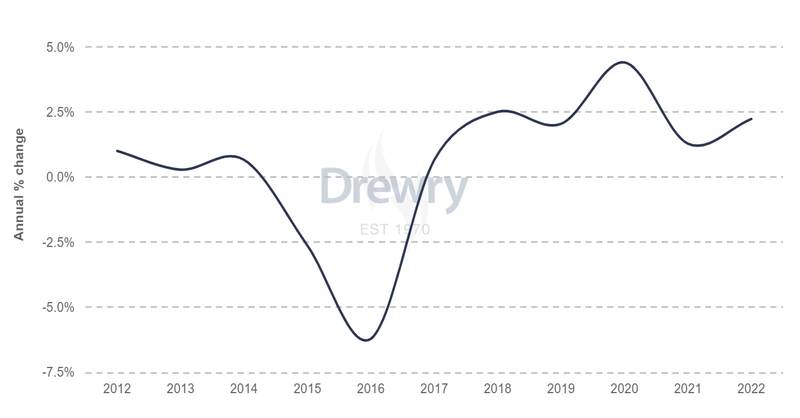Inflation Hits Vessel Operating Costs -Drewry
Vessel operating cost inflation has accelerated in 2022 on mounting worldwide macroeconomic price pressures, despite some receding of Covid-19 related costs, according to the latest Ship Operating Costs Annual Review and Forecast 2022/23 report published by global shipping consultancy Drewry.
Drewry estimates that average daily operating costs across the 47 different ship types and sizes covered in the report rose for the fifth consecutive year to reach $7,474 in 2022, a rise of 2.2%. This compares with a much smaller 1.3% increase last year and a pre-pandemic trend of flatlining or declining costs (see chart). While broader pricing pressures remain, vessel opex inflation is forecast to moderate over the medium term.
 Drewry ship operating cost index (annual % change). (Source: Drewry’s Ship Operating Costs Annual Review and Forecast 2022/23)
Drewry ship operating cost index (annual % change). (Source: Drewry’s Ship Operating Costs Annual Review and Forecast 2022/23)
“The rise in opex was driven mainly by price inflation in goods and services across the shipping sector, as well as supply chain disruption induced by the Covid-19 pandemic,” said Latifat Igbinosun, head of vessel opex research at Drewry. “Cost inflation was restrained last year, especially for repair and maintenance, as owners took advantage of the resumption in trade growth and rising vessel earnings to keep ships in service for longer. However, vessels returned to yards this year, pushing up costs.”
A high proportion of the 2022 opex increase was driven by lubricating oil costs, which surged 15% due to limited refinery supply and high oil prices. Costs also increased for marine insurance cover which rose 8% on average, following a 7% uplift in 2021, driven by a hardening insurance market and higher vessel values in some sectors which pushed up H&M premiums.
Cost inflation was also evident in other opex headline items. For instance, dry-docking costs rose 6% in 2022 due to limited slots as shipyards opted for profitable new orders and retrofitting projects. Meanwhile, stores and spares costs increased 2% apiece, while manning costs flatlined due to the unwinding of some Covid-19-related costs.
The rise in costs was broad-based across all the main cargo carrying sectors. The latest assessments include vessels in the container, dry bulk, product, crude, LNG, LPG, general cargo, reefer, ro-ro, and car carrier sectors.
Looking ahead, over the near term, a slowdown in many seaborne trades is anticipated with the exception of the energy-related commodity trades such as oil and gas, which will significantly affect available budgets for spending on vessel operations over the next few years. Drewry expects downside pressure on costs to remain in those areas where vessel owners have greater control, but tightening seafarer availability and ongoing decarbonisation regulations are expected to add to owners’ cost burden over the medium term.
“The outlook for vessel operating costs remains uncertain, given ongoing geopolitical risks, rising inflationary pressures and deteriorating economic outlook,” added Igbinosun. “But Drewry forecasts some moderation in opex inflation as pressures on certain cost heads such as marine insurance and dry docking recede, despite the risk of rising seafarer wage costs in light of a looming officer shortage.”











